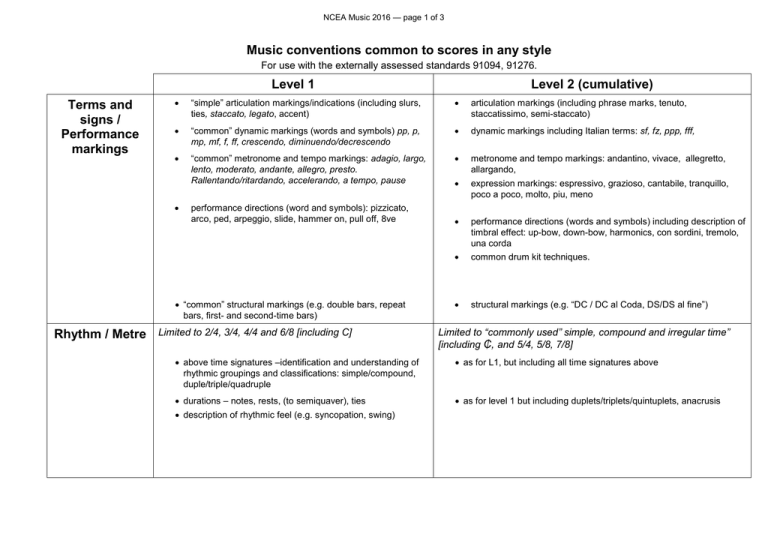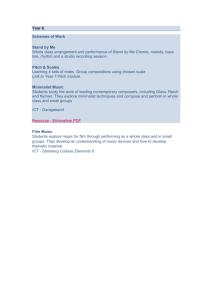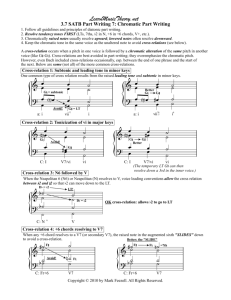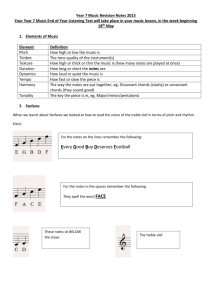Conventions Levels 1–2 (DOCX, 31KB)
advertisement

NCEA Music 2016 — page 1 of 3 Music conventions common to scores in any style For use with the externally assessed standards 91094, 91276. Level 1 Terms and signs / Performance markings “simple” articulation markings/indications (including slurs, ties, staccato, legato, accent) articulation markings (including phrase marks, tenuto, staccatissimo, semi-staccato) “common” dynamic markings (words and symbols) pp, p, mp, mf, f, ff, crescendo, diminuendo/decrescendo dynamic markings including Italian terms: sf, fz, ppp, fff, “common” metronome and tempo markings: adagio, largo, lento, moderato, andante, allegro, presto. Rallentando/ritardando, accelerando, a tempo, pause metronome and tempo markings: andantino, vivace, allegretto, allargando, expression markings: espressivo, grazioso, cantabile, tranquillo, poco a poco, molto, piu, meno performance directions (words and symbols) including description of timbral effect: up-bow, down-bow, harmonics, con sordini, tremolo, una corda common drum kit techniques. structural markings (e.g. “DC / DC al Coda, DS/DS al fine”) performance directions (word and symbols): pizzicato, arco, ped, arpeggio, slide, hammer on, pull off, 8ve “common” structural markings (e.g. double bars, repeat bars, first- and second-time bars) Rhythm / Metre Level 2 (cumulative) Limited to 2/4, 3/4, 4/4 and 6/8 [including C] Limited to “commonly used” simple, compound and irregular time” [including ₵, and 5/4, 5/8, 7/8] above time signatures –identification and understanding of rhythmic groupings and classifications: simple/compound, duple/triple/quadruple as for L1, but including all time signatures above durations – notes, rests, (to semiquaver), ties as for level 1 but including duplets/triplets/quintuplets, anacrusis description of rhythmic feel (e.g. syncopation, swing) Pitch / Tonality Harmony Limited to major and minor keys, up to three sharps and three flats Limited to major and minor keys, of up to four sharps and four flats [no modes] clefs – treble, bass, alto C-clef, percussion, and “vocal tenor” (i.e. treble-octave) as for L1, plus tenor C-clef, guitar TAB key signatures and scales– recognition of major and minor keys (harmonic and melodic), plus addition of Blue notes key signatures and scales- as for L1 plus natural minor, and chromatic key relationships (scale degrees) – tonic, subdominant, dominant, relative major and minor as for L1, plus tonic minor and supertonic pitch names: tonic↔leading note intervals – recognition of major, minor and perfect intervals within an octave; lower note can only be the tonic of one of the permitted major keys (i.e B-flat, F, C, G, or D) as for L1, plus augmented 4th/diminished 5th; same limitation on lower note (but range of possibilities is greater) transposition – upwards only, sounding pitch → written pitch only, limited to instruments in B-flat and F also instruments transposing 8ve transposition upwards or downwards, sounding pitch pitch, limited to instruments in B-flat, E-flat, and F, transcription – from treble clef ↔ bass clef, from alto clef↔ other clefs, open ↔ closed score, written pitch → sounding pitch (i.e. vocal tenor, double bass, piccolo) as for L1, plus from tenor clef↔ other clefs, written pitch → sounding pitch (guitar/bass guitar) Limited to chords I, IV, V, V7, and VI, in major and minor keys, in root position only ↔ written Limited to chords I, Isus4, II, IV, V, V7,Vsus4 and VI, in major and minor keys, in root, first, and second inversion chords – identification of individual chords using Roman numerals and jazz / rock notation as for L1, with a wider range of chords and inversions chord progressions – identification of cadences (perfect, plagal, imperfect I-V and IV-V only, interrupted) add imperfect cadence II-V, and no restriction on inversions chords – notation of individual chords chord progressions – notation of cadences in root position (perfect [V–I only, no V7], plagal, imperfect [I–V only]); no interrupted cadence modulation – identification of modulation (via perfect cadence) to related keys (subdominant, dominant, relative major and minor) as for L1, plus tonic minor Instrumentation Limited to scores of no more than 16 instruments. Limited to common orchestral and jazz / rock instruments, and common voice types Form / Structure score layout – recognition of family / instrument order, English names Limited to identification and supporting evidence of: introduction A–B / binary Scores of varying levels of complexity including common symphonic, chamber, choral and jazz / rock ensembles. add Italian names Identification, and some analytical description required. No constraints on types of forms e.g. rondo, theme and variations, strophic A–B–A / ternary verse–chorus 12-bar blues bridge outro / coda Compositional devices Melodic / rhythmic / textural devices e.g. As for L1, plus: sequence motifs/riffs and their development repetition phrases - regular and irregular ostinato augmentation and diminution motif/riff inversion imitation canon / fugato Pedal note variation and thematic development Syncopation melodic range and contour Similar/contrary motion Texture textural features e.g. monophonic homophonic polyphonic melody and accompaniment, layering (e.g. background, foreground) textural density textural features e.g. heterophonic countermelody antiphonal imitation, fugue textural density





